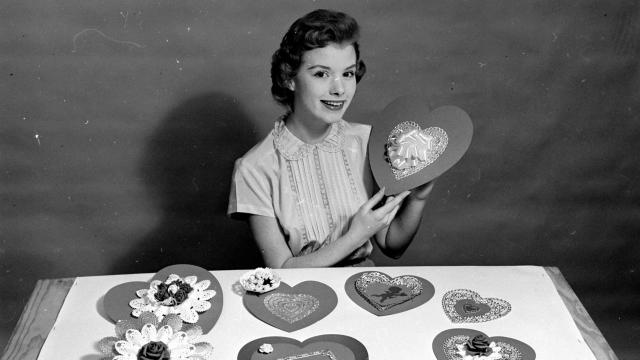It’s almost Valentine’s Day. Sometimes called “Oh, shit, I forgot again” Day, the annual Feb. 14 celebration of love is marked by candy, greeting cards, and difficult-to-obtain dinner reservations, but where did Valentine’s Day come from? Why do we celebrate it? Who said we have to give people candy? What does it all mean? I’ll answer all those questions and more below.
The surprisingly long history of Valentine’s Day
Valentine’s Day is not a modern, created-by-Hallmark-and-Big-Candy holiday. The first Valentine’s Day was in 496 AD, when Pope Gelasius I established a feast day to honour the martyr date of Saint Valentine of Rome. By the Middle Ages, the modern traditions of Valentine’s Day — love, poetry, gifts — were already in place.
The real Saint Valentine
The true story of the Saint Valentine is mostly lost to time. There were apparently three early Christians named “Valentine” who were martyred by Romans, but we don’t know the story of any of these early Valentine’s lives. Firsthand accounts were probably destroyed during the Diocletianic Persecution in the early fourth century.
Over the years, myths and legends of Saint Valentine sprang up — he supposedly was known for secretly performing Christian marriages for Roman troops. Or he was imprisoned in Rome, but restored his jailer’s daughter’s sight while awaiting his execution, sending her a card that ended, “From your Valentine.” These tales are probably holiday retcon, made up at later dates to pretend it all made sense from the beginning. As the Catholic Church put it in 1969, “Though the memorial of Saint Valentine is ancient…apart from his name, nothing is known of Saint Valentine except that he was buried on the Via Flaminia on February 14.”
Even though we don’t much about him, you can still visit a flower-festooned skull purported to have once belonged to Saint Valentine at the Basilica of Santa Maria in Cosmedin, Rome. Creepy!
Geoffrey Chaucer: The actual father of Valentine’s Day
Before the 1300s, the Feast of Saint Valentine was just another Catholic holiday sandwiched between St. Blase’s Feast Day on Feb. 3 and the Feast Day of St. Polycarp on Feb. 23. Then English poet Geoffrey Chaucer came along and shook up the holiday game for all time.
In Chaucer’s Parliament of Fowls, published in 1382, he explicitly associates Valentine’s Day with romantic love, imagining that this is the day birds choose their mates.
Courtly love was a big deal at the time, and by 1400, Valentine’s Day had caught on enough that Charles VI of France describes lavish court parties on Feb. 14 that include feasting, love song and poetry competitions, jousting, and dancing. Shakespeare mentions Valentine’s Day in Romeo and Juliet, and we even get the first “Roses are red, violets are blue” rhyme from Edmund Spenser’s The Fairy Queen in 1590. (“She bath’d with roses red, and violets blew, And all the sweetest flowres, that in the forrest grew.”)
Modern Valentine’s Day: Candy and cards
By the Victorian Age, sending your love a note emblazoned with hearts was a long established yearly tradition in England. In America, people were writing each other love notes, too, but it wasn’t until 1847 that the holiday went industrial. Ester Howland, daughter of a stationary store owner, started mass-producing embossed, lacy Valentine’s Day cards in 1847, setting the scene for the modern tradition of using the sentiments of greeting card company employees to express our deepest feelings for one another.
We can thank Cadbury for the tradition of giving candy for Valentine’s Day. In 1868, the British confectioner started selling “Fancy Boxes,” a box of chocolates in the shape of a heart, for Valentine’s Day. These obviously caught on, and heart-shaped boxes of candy can be purchased for next-to-nothing on Feb. 15th.
South Korea: Winner of Valentine’s Day
Today, Valentine’s Day is celebrated all over the world, usually as a minor holiday, but the best interpretation of the holiday (at least among heterosexual couples) goes to South Korea. They celebrate twice, but they don’t leave out single people. Valentine’s Day is on Feb. 14 and designated as a day that women buy their romantic partners candy. March 14, known as White Day, is when men return the favour. The growing popularity of these lovey-dovey holidays led to “Black Day.” Observed on April 14, Black Day sees single people who received no candy in the previous two months “celebrating” by eating black noodles, or getting together with friends and saying, “Thank god I didn’t marry that one.”
Valentine’s Day backlash
The disappointment of Valentine’s day for single people is obvious — just look at Ralph Wiggum — but there’s a more serious side to anti-Valentine’s day sentiment. Pakistan and Indonesia have both banned the holiday, and it’s become a cultural flashpoint in Iran.
Valentine’s Day grew in popularity in Iran throughout the 2000s, particularly among young people, leading to a backlash among Iranian Conservatives. Decrying the spread of “decadent” Western culture into Iran, in 2011, authorities began discouraging celebrations and restricting the sale of Valentine’s-related goods. Reportedly, young people still get together on the day, but they do it without red boxes and other outward Valentine-ness.

Leave a Reply
You must be logged in to post a comment.